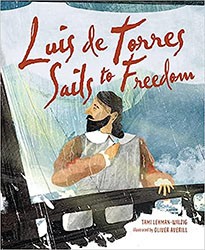This illustrated novel for young readers is a compact introduction to the lives of Portugal and Spain’s secret Jews. Set in Lisbon in the early sixteenth century, The Inside Name follows one converso family as they take measures to conceal their Jewish identity and keep themselves safe. Like many Sephardic Jews, Felipe Alonso’s grandfather flees persecution in Spain and settles in Portugal, only to find that the Inquisition is enforcing the same policy of forced conversion in his new home. The dangers of secretly practicing Judaism force Felipe’s family to seek refuge elsewhere, in a land where Felipe can reclaim the secret Hebrew name that represents his true identity.
Felipe is able to escape the rigid confines of his dual life by pretending he is a king. He imagines for himself a fairy-tale world in which “the Tagus River gleams like a blue satin ribbon dotted with the white sails of merchant ships.” By applying painterly touches to the ordinary speech of a child, Randi Sonenshine captures the particular way that Felipe incorporates fantasy into his daily life. Her language is both rich with metaphor and highly accessible.
Although the main characters are fictional, the historical figure of Doña Gracia Nasi plays a key behind-the-scenes role. Felipe’s parents explain to him how the courageous Jewish woman uses her wealth and influence to help her people in their quest for freedom. A two-page map, clearly labeled and decorated with ships sailing on their course, anticipates the family’s imminent journey to a haven in Italy. Elsewhere in the book, unobtrusive text boxes provide important information and vocabulary. The author balances history, drama, and character development to create an exciting tale with a satisfying resolution. Only on the book’s final page is Felipe’s true name revealed.
Reflecting on his time in Portugal, Felipe remembers his friend, Solomon, whose name alludes to an era when Jewish leadership was not just a dream. Before Felipe left, Solomon gave him the gift of a chess set. Felipe decided to hide the set’s two kings in a secret location.
Complete with an informative afterword, this book will give readers a vivid sense of the survival strategies that enabled at least some Iberian Jews to remember their inside names.
Emily Schneider writes about literature, feminism, and culture for Tablet, The Forward, The Horn Book, and other publications, and writes about children’s books on her blog. She has a Ph.D. in Romance Languages and Literatures.





